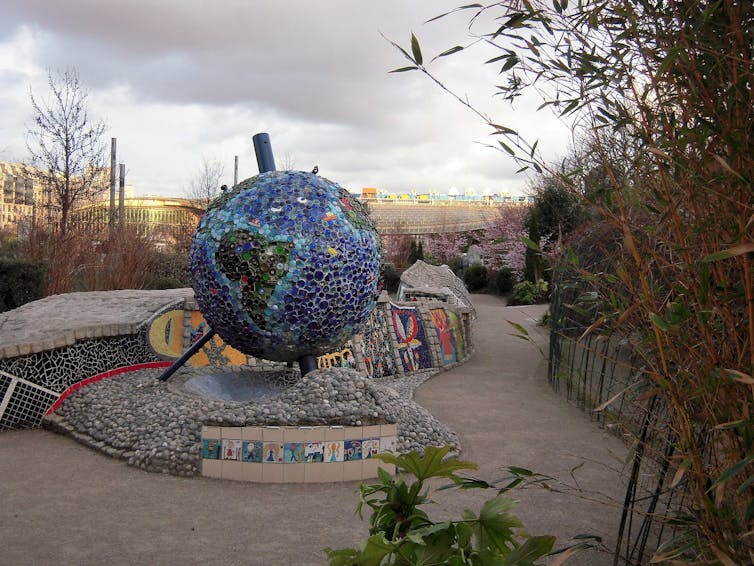Adventure playgrounds to redefine children's place in the city
Invented almost a century ago in Denmark, adventure playgrounds are free activity areas for children, enabling them to reclaim public space. In recent years, creative projects based on this concept have been multiplying in France. How can we analyze this renewed interest? Do these areas represent new fields of experimentation and education?
Sylvain Wagnon, University of MontpellierDelphine Patry, University of Caen Normandie and Mathieu DEPOIL, Université Paul Valéry - Montpellier III

Their history began in the early 1930s, under the impetus of Carl Theodor Sørensen (1893-1979). This Danish landscape architect envisioned a new kind of space, where children could give free rein to their inventiveness, try out new experiences, and where the adult footprint would be minimal. His aim was to enable children to imagine and construct their own world.
In 1943, the first adventure playground was opened in Emdrup, a suburb of Copenhagen. But it was in England that the movement gained momentum, in a country where the adventure playground came to be defined in opposition to the square, the standardized city playground.
In the 1950s, the pace of development accelerated on the European continent (Denmark, Sweden, Switzerland, Germany, France). Faced with increasing urban densification, adventure playgrounds sprang up at the foot of new buildings.
Educational utopias
Initiatives took shape after May 1968, based on educational and political utopias. The wastelands of the suburbs were transformed into spaces for play and discovery. In 1979, the phenomenon spread to Berkeley in the United States and to Japan.
In France, the projects are developing as new spaces for ecological struggles. The adventure playground became the site of anti-authoritarian educational practices, new collective forms of living and the appropriation of urban wastelands. In an article in Le Monde by Katie Breen, published in 1976, Dominique d'Allaines-Margot describes her experience as a youth worker in the new housing estate of Bouffémont in the Val-d'Oise:
"The adventure playground offers children a completely different role and attitude from what is usually imposed on them. At school, they're expected to recite their lessons. At home, they're expected to behave... In the public garden, play structures are made for climbing and jumping, and they always elicit certain gestures. On the adventure playground, children are told: "Anything goes. But we don't expect them to do anything very specific.
The adventure playgrounds of the 1970s and 1980s were spaces for popular education, like Bellevue, in Nantes, or Meinau, in the Strasbourg suburbs, where children made their own games using recycled materials and tools provided by educators who guided and accompanied them.
Precarious and subject to real estate pressure, most of these experiments struggle to survive. But the idea continues to gain ground, with free spaces like the Petits Pierrots adventure playground, created in 1988 in the 20th arrondissement of Paris. Today, there are approximately 1,000 adventure playgrounds worldwide.
A new era
Over the past few years, initiatives have been gathering pace again in France, in line with the recent trend to revegetate urban spaces. Projects are spreading to the Île-de-France (Villiers-le-Bel, Rambouillet, Bagnolet), Pays de la Loire (Nantes, Cholet, Angers, Saint-Nazaire, Orvault), Reims, Bordeaux, Marseille and, in summer 2021, Montpellier.
Often initiated and supported by the CEMEA (Centres d'Entraînement aux Méthodes d'Éducation Active), all these adventure playgrounds perpetuate this history and these struggles for common spaces within the city, with today's precise objectives: to rethink the place of the child in the city, and to encourage his or her autonomy.

Patrick Janicek/Fickr, CC BY
Creating a place for children, designed by them, is an innovative vision of education and urban space. Don't popular education projects make it possible to rethink the links between residents and urban policies?
The adventure playground has become an object of research with the Tapla network (Terrains d'aventure du passé/pour l'avenir), initiated by Baptiste Besse-Patin, Aurélien Ramos, Gilles Raveneau and Clothilde Roullier as an international, multidisciplinary and open network studying the legacy of adventure playgrounds and their prospects.
Free activities
Recent studies show the importance of free activities in children's development. They promote an all-round education, taking into account the different facets of each child's personality: intellectual, manual, physical and emotional.
Rather than offering structured activities, adventure playgrounds encourage this approach, building on children's needs and desires, and their curiosity to build, garden, care for animals or simply observe their environment.
Also read:
Nature at school: is it time for an outdoor classroom?
There is no initial desire for formal learning, and this freedom implies risk-taking. The adventure playground is thus conducive to the discovery of autonomy. Getting to know oneself better, understanding others better and the need to be with others, are elements in the construction of this individual and collective autonomy.
Assessing the risks we take is essential to children's learning, development and health. On these fields, they will test their own limits, cooperate, exchange, share and commit themselves.
To perpetuate these experiments and help them spread, we should consider drawing up a charter for adventure playgrounds. This would make it possible not only to better define their social and educational intentions - which differ from those of the play ground - but also to establish the convergences and differences between projects.
This article was written in collaboration with the CEMEA Occitanie team.![]()
Sylvain Wagnon, Professor of Education, Faculty of Education, University of MontpellierDelphine Patry, Doctor of Education, ATER at the University of Caen-Normandie, associate member of CIRNEF, University of Caen Normandie and Mathieu DEPOIL, PhD student in Education at Liderf - University of Montpellier, Université Paul Valéry - Montpellier III
This article is republished from The Conversation under a Creative Commons license. Read theoriginal article.